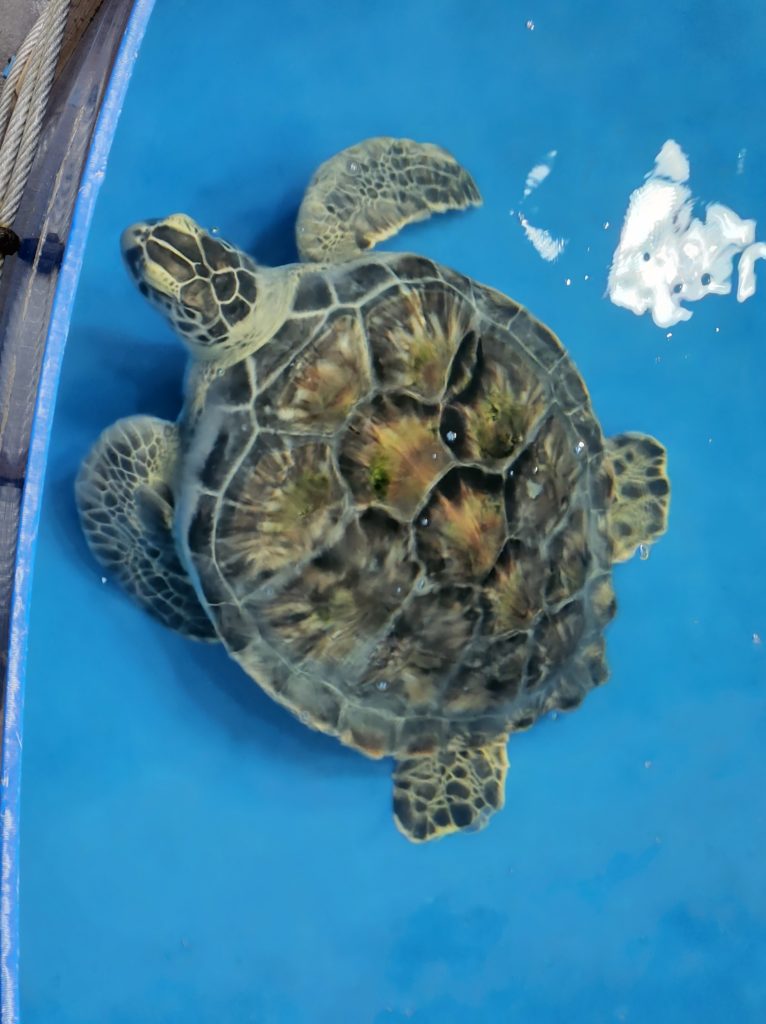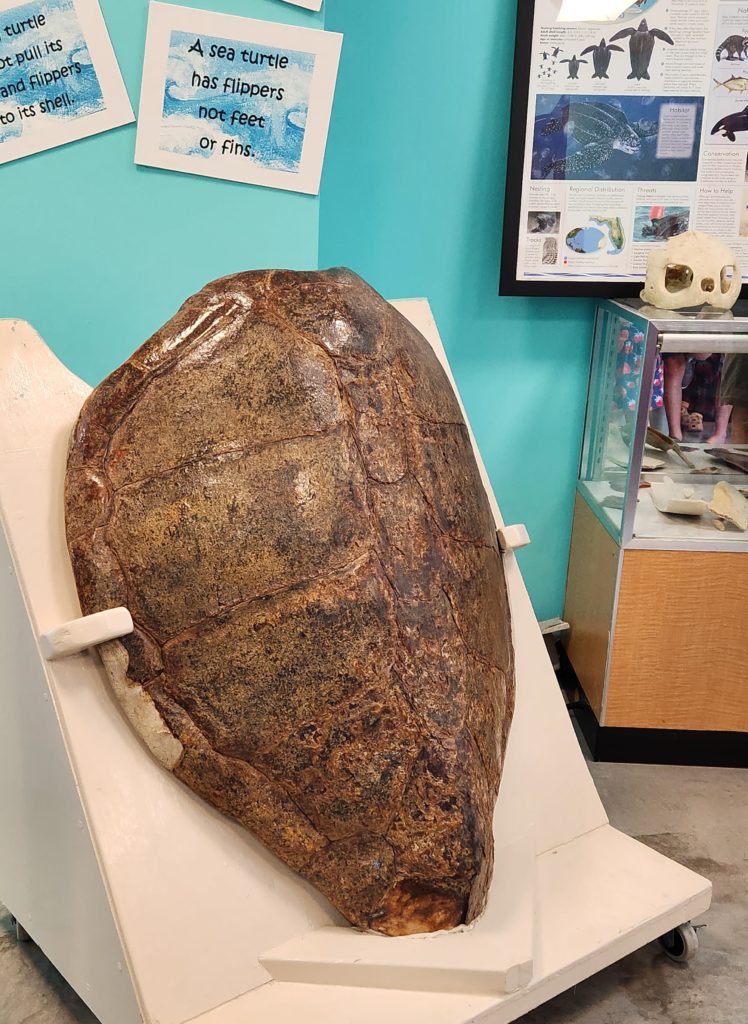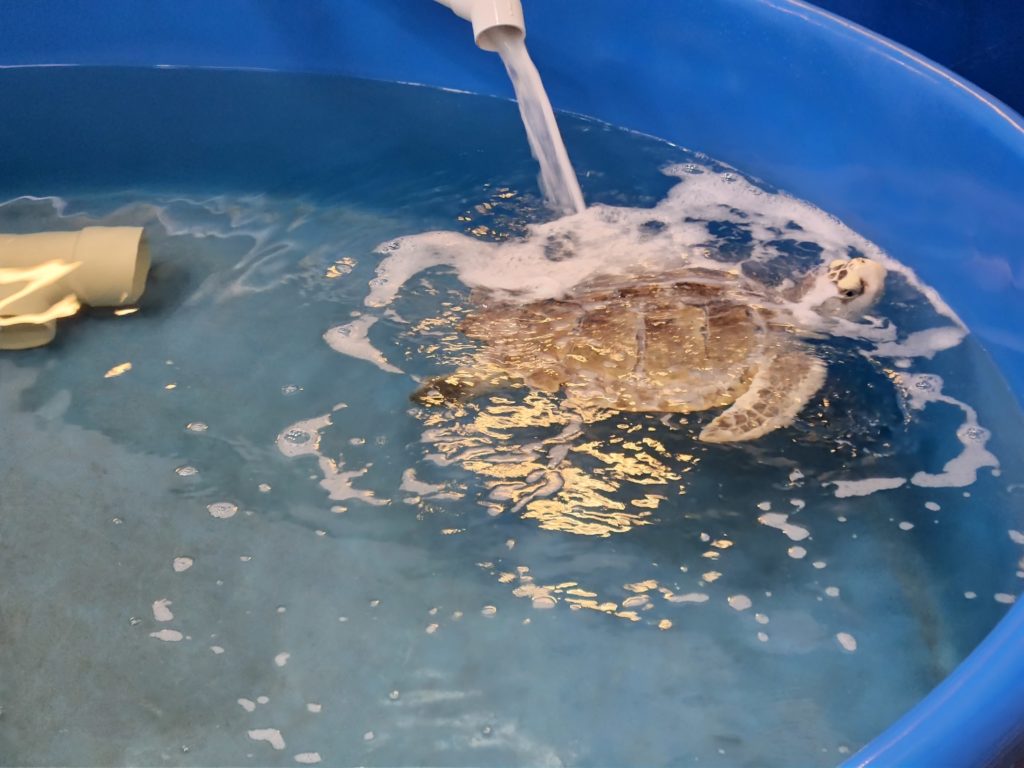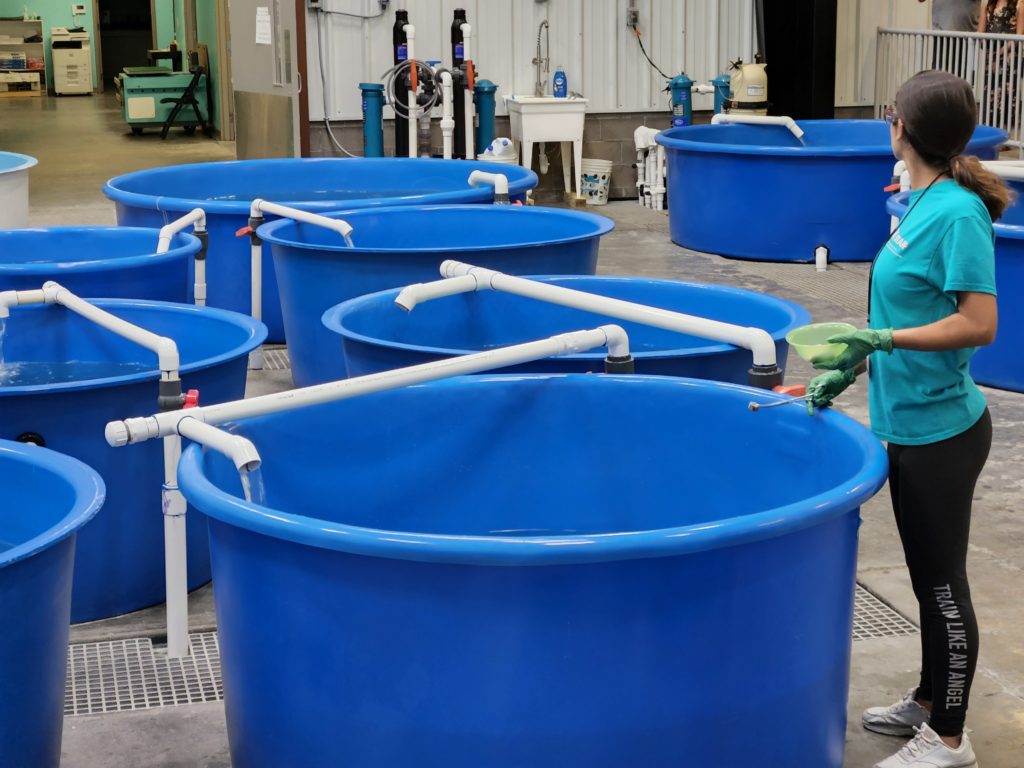In the 25+ years that the Karen Beasley Sea Turtle Center has been in operation, they have kept over 2500 sea turtle nests safe and treated over 1300 sick or injured turtles. Averaged out, that’s over one turtle per week that the center has treated and released back into the ocean, and two nests full of baby sea turtles that were given a better chance at survival. This is a HUGE step in helping these beautiful creatures to move off of the endangered list and back into a thriving species.
This mission started because one woman made it her life’s goal to help protect sea turtles.

The Karen Beasley Sea Turtle Center started out as the Topsail Turtle Project. Karen organized this project to help protect turtle mamas that were coming up onto the beach to lay their nests, and to watch over the nests until they hatched a couple of months later. When she passed away, her mother, Jean, took over and continued the project in her honor.
As this project grew, so did the space that was needed to house all of the turtles that they were helping. For the first 16 years, the crew worked out of a building that was 900 square-feet. With up to 40 turtles at a time, along with all of the equipment and volunteers needed to care for them, you can imagine how cramped it was. So, in 2010, with the help of tons of donations and hard work, they broke ground on their new place. They moved into their upgraded 13,000 square-foot space in 2013 and that’s where they’ve been ever since.
You can take a tour of the Karen Beasley Sea Turtle Center (located at 302 Tortuga Ln. Surf City, NC), and I highly recommend that you do, just remember that this is a working hospital for our sea turtle friends.

Some people are disappointed when they visit and they don’t get to touch the turtles, or get closer to them. Which I 100% understand. BUT, like any wild animal, the more we interact with them, by petting them, hand feeding them, etc., the more likely they are to come to depend on us for those things. This is ok if it’s our personal dog, cat, or other domesticated pet, but not for those that will be returned to the wild when they recover.
Since this is the entire mission of the Karen Beasley Sea Turtle Rescue and Rehabilitation Center – helping the turtles recover and return to the ocean – even those that work with the turtles every single day do their best to handle them as little as possible. All of this effort helps to ensure that they have an easier time readjusting to life in the big blue.
(Visit their website to book a tour.)
What can you expect on a tour?
During the tour, you will get to learn all about the life of a sea turtle, and what the Karen Beasley Sea Turtle Center does to help them.
First, you’ll stop at several different stations that will help you learn all about the life of a sea turtle, and about what the Karen Beasley Sea Turtle Center does to help them. You’ll get to see visual examples of things like a sea turtles’ nest, the anatomy of a sea turtle, and some of the dangers that they face.


Next, you’ll come to a window that looks into the hospital section of the center, where turtles will spend their first few weeks. They put them in this section to ease them into being here, to monitor them closely and find out how to help them, and also to make sure that they don’t have anything that could harm the other turtles.

Most of the tanks in the main room (lovingly called “Sea Turtle Bay”) are on the same water system, meaning the water that is filtered in and out of the tanks all goes into and comes from the same place. So, if one of the turtles has something that could harm the others, it could potentially be passed through this system. Leaving them in the hospital, where each tank is separate, gives the staff a chance to make sure that nothing will be passed along.
Your last stop is the “Sea Turtle Bay” where you can actually meet some of the patients, hear their stories, and see them splashing around.

A disclaimer: The splashing around part isn’t guaranteed. Just like us, the turtles have times when they are moving around a lot and times when they are resting. (The cover on this tank is so that they have a space to hide from the crowds a little and rest.) But both times we’ve visited there have been at least a few of them swimming around. Snooki especially. =) Read her story here.

The team at the Karen Beasley Sea Turtle Center really do everything they possibly can to not only help these turtles recover, but to thrive once they return to the ocean.
They work year-round taking in sea turtles that have been found stranded on beaches, caught in and on fishing lines, hit by boats, are cold stunned, etc. When the turtles are first brought in, they utilize some of the same diagnostic tools that would be used if we were to be taken to the hospital after an accident. Things like x-rays, MRI and CT scans, and blood tests. After they determine what the extent of the injuries are, a treatment plan is developed, and the turtles healing journey begins.
Interestingly, one of the things they use the most, that you wouldn’t expect, is honey. Yep…honey. Medical grade honey is a natural anti-inflammatory and anti-bacterial. It not only helps to bring the swelling down; it helps to heal any infection.
During their stay, the turtles will even receive hot oil treatments, massages, and get to take a swim in the therapy pool from time to time. This pool mimics the waves and currents of the ocean so it helps them build their strength back up as they heal. Anything to help them be at their absolute best when they are released.

Their tanks have different “enrichment” tools placed in them each day so that they have things to interact with in their environment. These items are taken out and cleaned each day, and rotated around so that each turtle always has something different.


Even the different ways that the turtles are fed gives them the opportunity to practice some of the skills they will use when they get back home. These include: 1) using tongs and moving the food through the water so that the turtles have to “chase” it; 2) putting different types of live food in the tanks so that the turtles have to dive down to get it; and 3) placing different kinds of lettuce or greens into holes in a fence like structure. All of these types of feeding mimic the natural ways that the turtles would have to go about getting their food in the ocean.

Seeing these gorgeous creatures up close is nothing short of amazing.
I learned a few things that I didn’t know when we took our tour:
1) When mamas come up on the beach to nest, they dig the holes that they lay eggs in as deep as they are big. So, the bigger the turtle, the bigger the hole. Our tour guide told us that they had one this year that was 37 inches deep. After the nest hatches, a team goes out and excavates the nest, counts the shells, etc. Can you imagine leaning over into a 37-inch-deep hole while you do this?? Haha.
2) The sex of sea turtles is determined by the temperature of the sand that the nest is in. If the temperature is warmer, there are more females. If it’s cooler, there are more males.
3) Sea turtles are fairly solitary creatures. The only time they really work together is when they are coming up out of the nest. The babies on the top push the sand out of the way. The ones towards the bottom pack the sand down to make a ramp of sorts so they can climb up and out. Once their out and they get to the ocean, they scatter and it’s every turtle for itself.
4) Sea turtles, unlike land turtles, can’t pull their head back into their shell to hide.
5) When they are sleeping, they will go to the bottom and put their heads under something. At the center they give them tubs to hide under. In the wild they will use coral, rocks, or whatever else they can find.

6) The turtles like to have their shells scratched…kind of like we enjoy someone scratching our backs…so they put bristly brushes in their tanks and the turtles swim under them. In the ocean they would use rocks and such.
And everything that has been accomplished over the last 25+ years happened because one woman saw a need and chose to fill it as best as she could.
Karen Beasley’s passion inspired other people to join her mission, and 25 years later it still is. She is proof that one spark can start a roaring blaze that can light up the world. So never think that you and your efforts don’t mean anything.
If you would like to help the Karen Beasley Sea Turtle Center specifically, there are several ways to do so. You can:

1) Adopt a sea turtle. “Each adoption comes with a photo of your adopted turtle, an official adoption certificate, a species information card, and other gifts” (depending on the level).
2) Adopt a nest (during each nesting season – starting around April 1st).
3) Purchase any of the items in their shop.
4) Purchase items on their Amazon Wishlist that they use at the center each and every day. They often post needs on their Instagram page – @seaturtlehospital
And…if you live close by, they also have year-round volunteer opportunities and special events going on from time to time to help raise awareness and money for the turtles.
There are also some simple ways that you can help our sea turtle friends overall:
1) Take an extra bag with you when you walk the beach and pick up any trash that you see. If left on the beach, this trash makes its way back into the ocean and ends up being mistaken for food.
2) Along the same line, avoid using plastic bags whenever possible. Plastic bags have a way of ending up in the ocean as well. A lot of turtles enjoy snacking on jellyfish. If there is a plastic bag floating in the water, it can easily be mistaken for a jellyfish and gobbled up by an unsuspecting turtle.
3) Fill in any holes that you dig, and knock down any sand castles that you build, before leaving the beach for the day. Even the smaller holes that our umbrellas make can trap a baby sea turtle that is trying to get to the ocean. In a similar way, large mounds of sand, like the castles we build, can hinder both a mama from getting high enough to safely nest and babies from getting down to the water. Have fun, take lots of pictures of the awesome sand castles you built and words that you wrote in the sand, but then even it all back out before you leave.

4) Find a way of celebrating that doesn’t involve balloons. Even if you’re miles away from the beach, balloons can still end up in the ocean. They break loose and float out over the ocean, then as they lose their air they fall into the water. Then, like the plastic bags, they are mistaken for food. Our tour guide showed us a balloon with a string that was about 3 feet long that they pulled out of a turtle recently. There are so many other ways that we can celebrate so that this doesn’t happen.
To find out more about the Karen Beasley Sea Turtle Center and how you can visit them, go to their website – seaturtlehospital.org – and follow them on Instagram – @seaturtlehospital to see the new patients and those that are being released back into the ocean.
